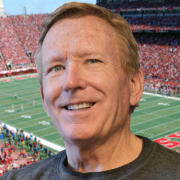Memorial Stadium: The Third Decade, 1943-52
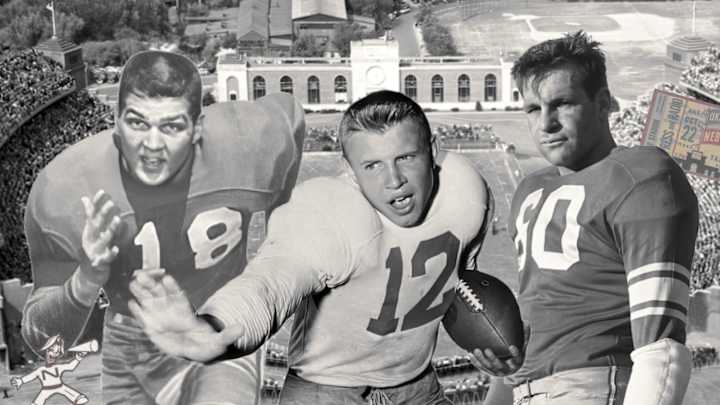
Sixth in a series marking the 100th season of Nebraska football in Memorial Stadium. Pictured above are All-Americans Jerry Minnick, Bobby Reynolds and Tom “Train Wreck” Novak. |
|---|
Nebraska’s third decade in Memorial Stadium began with A.J. Lewandowski cobbling together wartime teams consisting largely of 17-year-olds and military rejects. Wins were few and revenues thin. No more than 8,000 fans typically showed up on Saturdays in Lincoln.
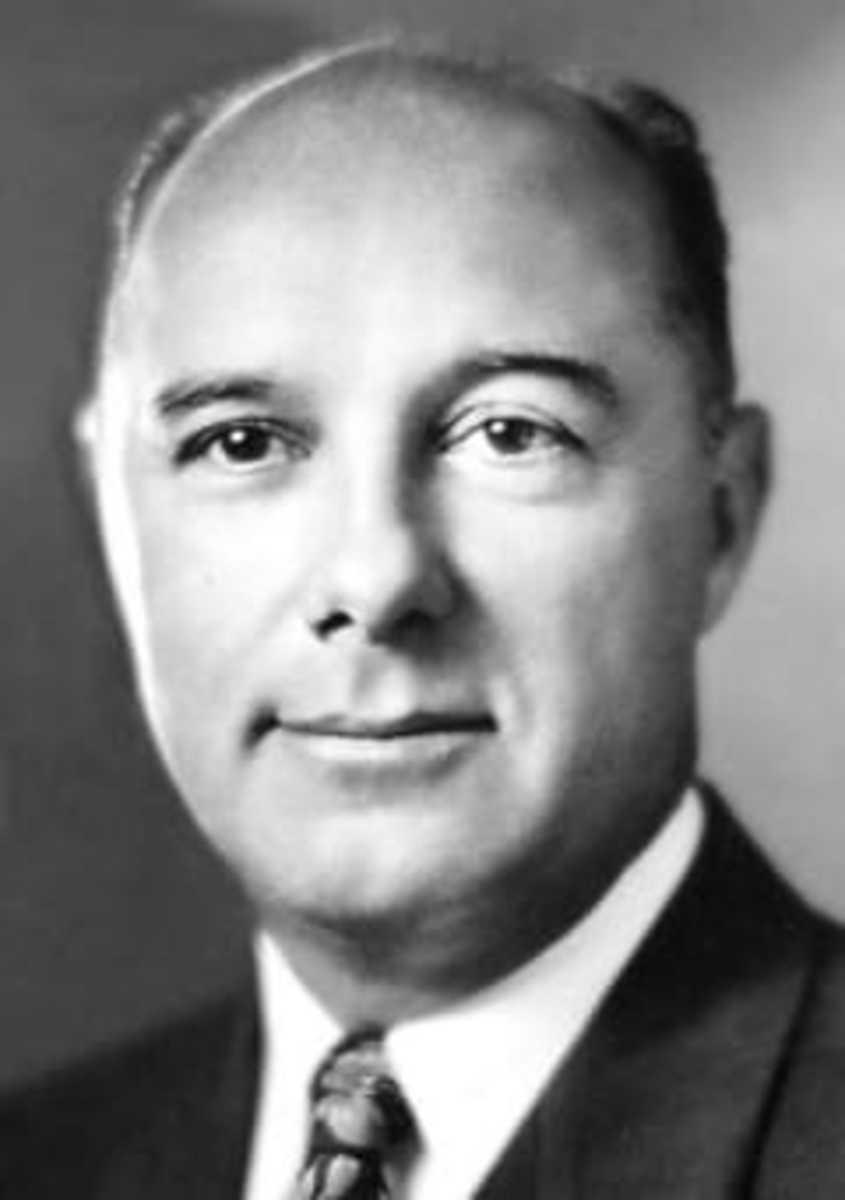
“Lew” was a veritable one-man band keeping Nebraska athletics afloat in 1943 and ’44. At one point he wore four hats at once: head football coach, head basketball coach, business manager and acting athletic director.
War’s end did not bring the return of coach Lawrence “Biff” Jones, who declined an offer to become athletic director only. Though revered by many fans, the architect of Nebraska’s Rose Bowl season had made enemies in high places by firing line coach Link Lyman in late 1941.
What peacetime did bring was an influx of players who were grown men — hardened World War II veterans who in many cases had four years of immediate eligibility under the conference’s early postwar rules.
These new Cornhuskers included the likes of the legendary Tom “Train Wreck” Novak and future Pittsburgh Steeler Carl Samuelson. But head coach Bernie Masterson, a former Husker and Chicago Bear, could not parlay that into winning football. One problem was the complexity of the T-formation system he borrowed from the Bears — memorizing up to 300 plays was required. He was ousted after two seasons.
George “Potsy” Clark, whose single-season stints in ’45 and ’48 bookended Masterson’s years, tried to keep opponents on their heels with his multiple formations. One of them was the wide-open “Platte River spread.” Like Masterson, he chalked up more than twice as many losses as wins.
Clark stayed on as athletic director and hired Bill Glassford as head coach, bringing a semblance of stability after six coaching changes in eight years. The former Pitt lineman was just 34 when hired, but he coached with an old-school disciplinary streak. At the same time, he helped modernize the program in terms of recruiting and athletic scholarships. He also coached the first Black varsity players at Nebraska since 1913.
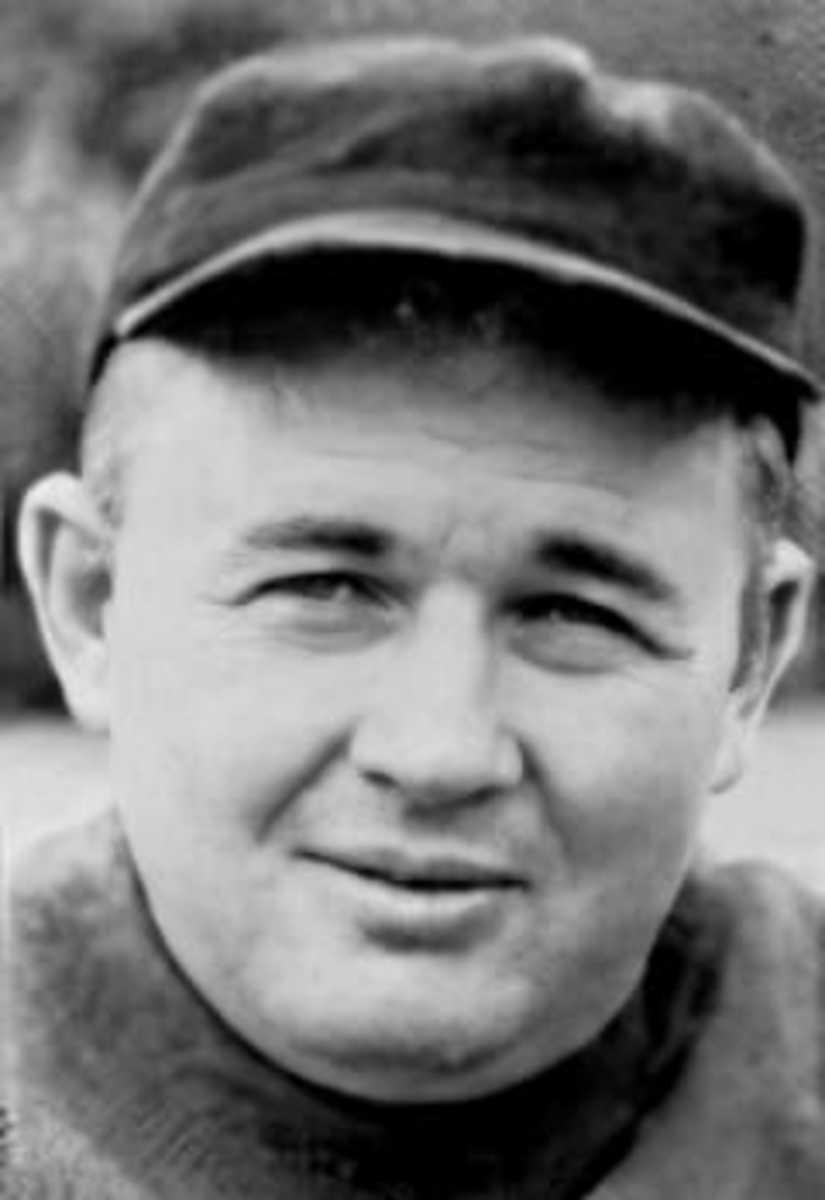
In his second season, Glassford’s 1950 Huskers exploded on offense like a bolt from the blue. Fueled by the brilliance of sophomore halfback Bobby Reynolds, Nebraska suddenly boasted the nation’s No. 2 rushing offense and No. 9 scoring offense. The 6-2-1 season and second-place conference finish, however, proved to be a flash in the pan. The Huskers slid back into middling territory as injuries dogged Reynolds during his junior and senior years.
Scroll past the facts box for a sampling of Memorial Stadium games from this 10-year span.
Just the Facts: 1943-52 |
|---|
• Home record: 19-26-1 (.424). • Overall record: 32-57-2 (.363). • Conference titles: None. • All-Americans: Tom Novak, 1949; Bobby Reynolds, 1950; Jerry Minnick, 1952. • Head coaches: A.J. Lewandowski, 1943-44; George “Potsy” Clark, 1945, 1948; Bernie Masterson, 1946-47; Bill Glassford, 1949-55. |
Just another mismatch
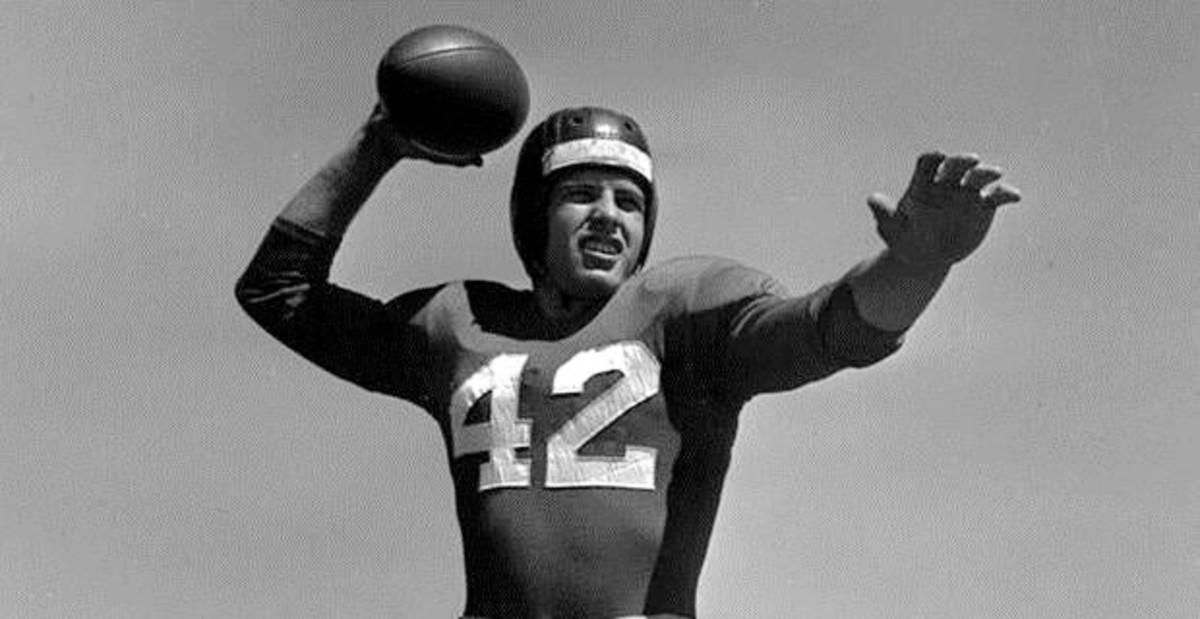
1943: Indiana 54, Nebraska 13. Bob Hoernschemeyer, shown above, found friendly skies in Lincoln as his passing arm scorched the Huskers for 345 yards and six touchdowns. It was the second of three 54-point surrenders for the 1943 squad, described by the Omaha World-Herald’s Floyd Olds as “the weakest Husker team in 53 years.” Do the arithmetic and it’s clear that meant the weakest ever. | Details
One shining hour
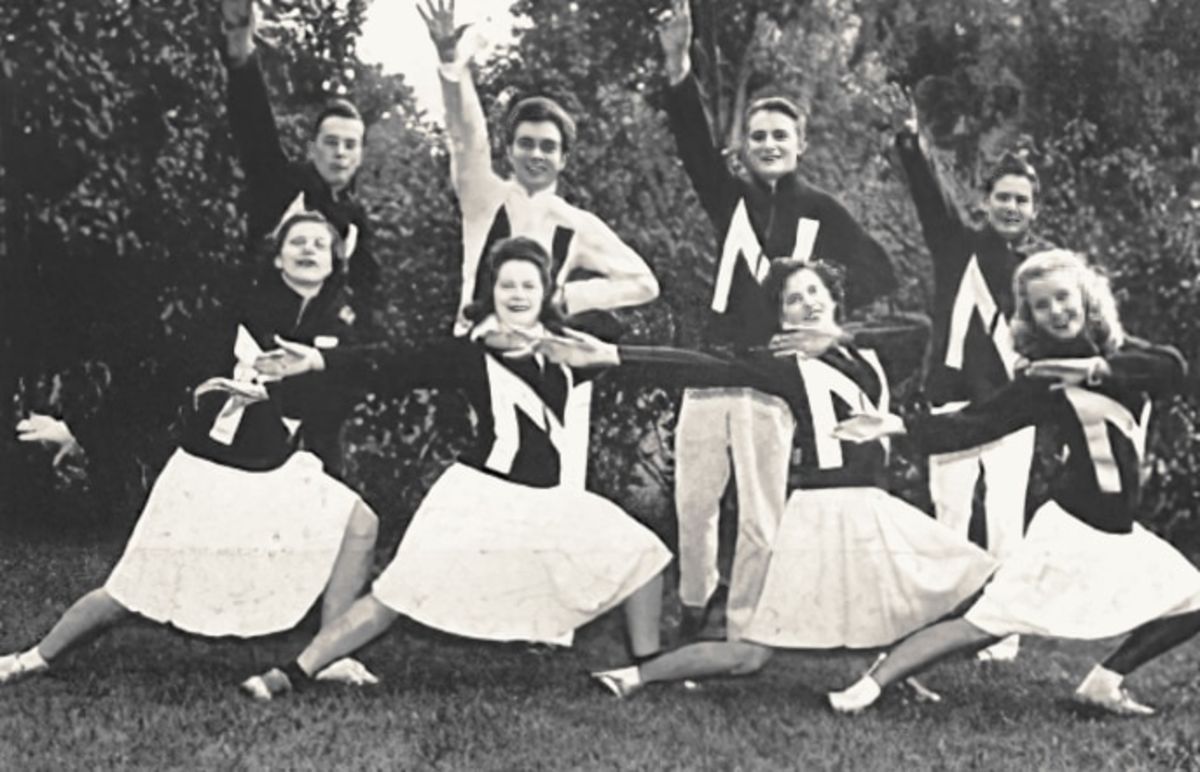
The Missouri game was the first with female cheerleaders.
1944: Nebraska 24, Missouri 21. Outscored 113-0 entering the fourth game of the season, the Huskers were expected to be easy prey. Instead, it was easily the Big Six upset of the year. Nebraska got just six first downs, but a fumble recovery, a 62-yard punt return and a 51-yard interception return set up three Husker touchdowns. | Details
A Saturday to forget
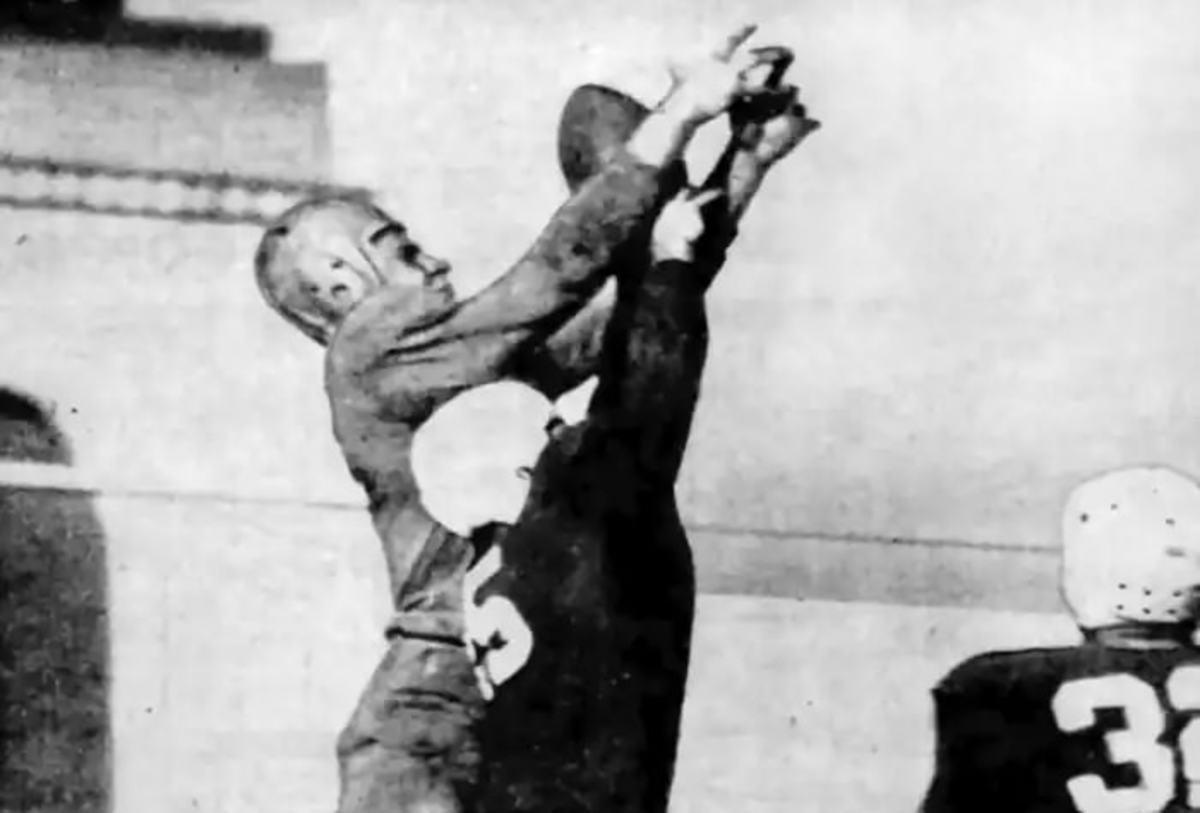
Bob Carley, left, makes a catch for the Gophers' eighth touchdown.
1945: Minnesota 61, Nebraska 7. The Gophers led by 21-7 at halftime, and then the bottom fell out for the Huskers. This remains Nebraska’s worst Memorial Stadium showing in terms of points allowed and losing margin. The Gophers outyarded the Huskers 538-85, but the Lincoln Star’s Cy Sherman was just thankful that Minnesota remained willing to keep the struggling Huskers on its schedule. | Details
Up off the mat
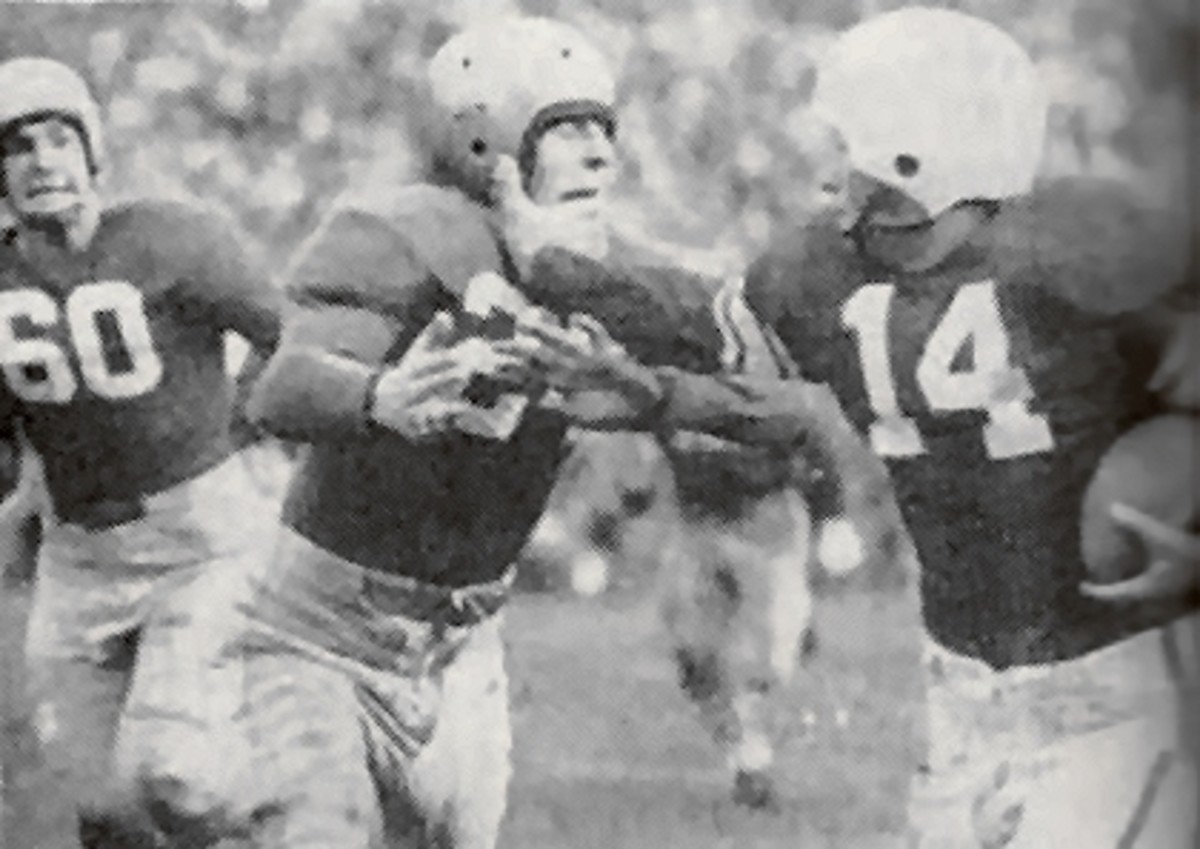
Cletus Fischer, No. 14, was one of the Huskers' four-year postwar players and went on to become a longtime Nebraska assistant coach. He's shown above against Notre Dame during his senior season. | Cornhusker yearbook
1945: Nebraska 13, Iowa 6. Seven weeks after the debacle against Minnesota, the Huskers wrapped up the season on a four-game winning streak. And they did it against an Iowa team that had just upset the Gophers. Freshman Cletus Fischer, who played at six-man St. Edward before the war, rushed for 141 yards as Nebraska’s spread formation opened up creases in Iowa’s defense. A fourth-quarter defensive stand preserved the win after Iowa had a first-and-goal at the Nebraska 3. | Details
Husker vs. Husker
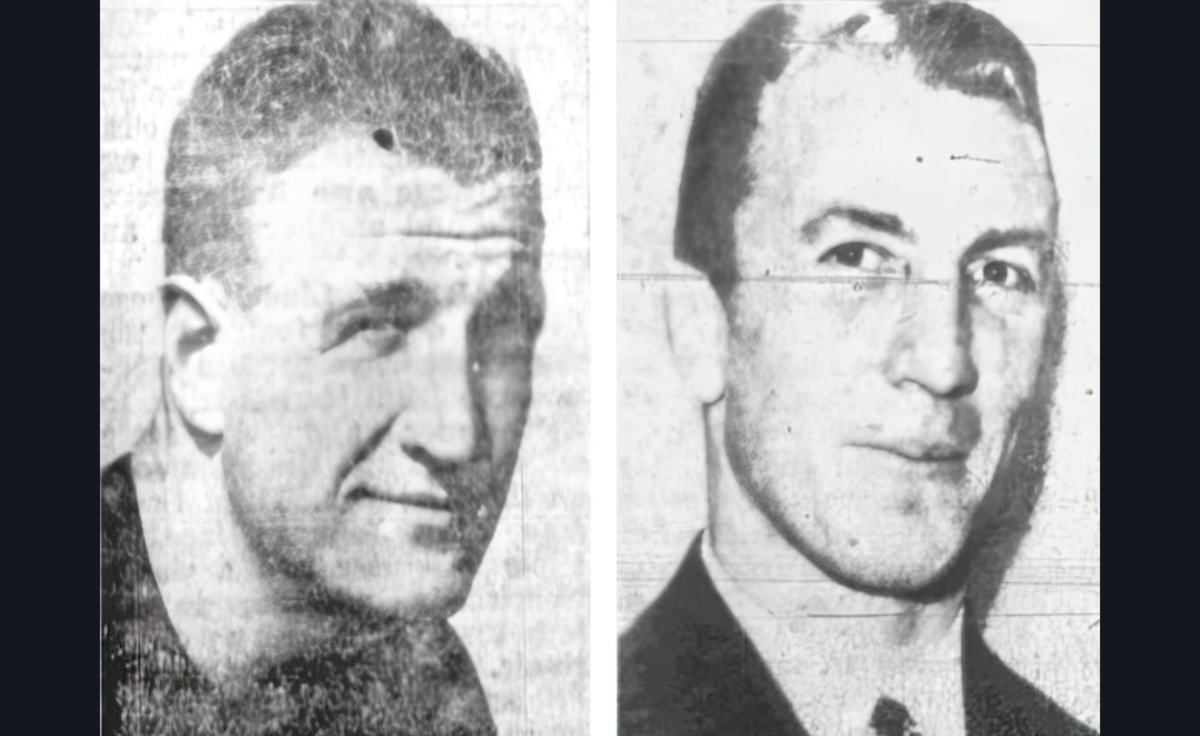
Masterson, left, and Sauer
1947: Kansas 13, Nebraska 7. In the early ’30s, George Sauer and Bernie Masterson were making plays together in Nebraska’s backfield. Now they were coaching on opposite sidelines in Lincoln, and Sauer’s Jayhawks dealt Masterson’s Huskers a heartbreaking defeat with a nine-yard touchdown pass in the final 40 seconds. Beaten on the play was Dale Adams, whose fancy footwork on 40-yard touchdown run had given Nebraska a 7-6 lead. The Huskers’ failed fourth-and-one gamble at the Kansas 38 with four minutes left set up KU’s winning drive. | Details
A budding dynasty
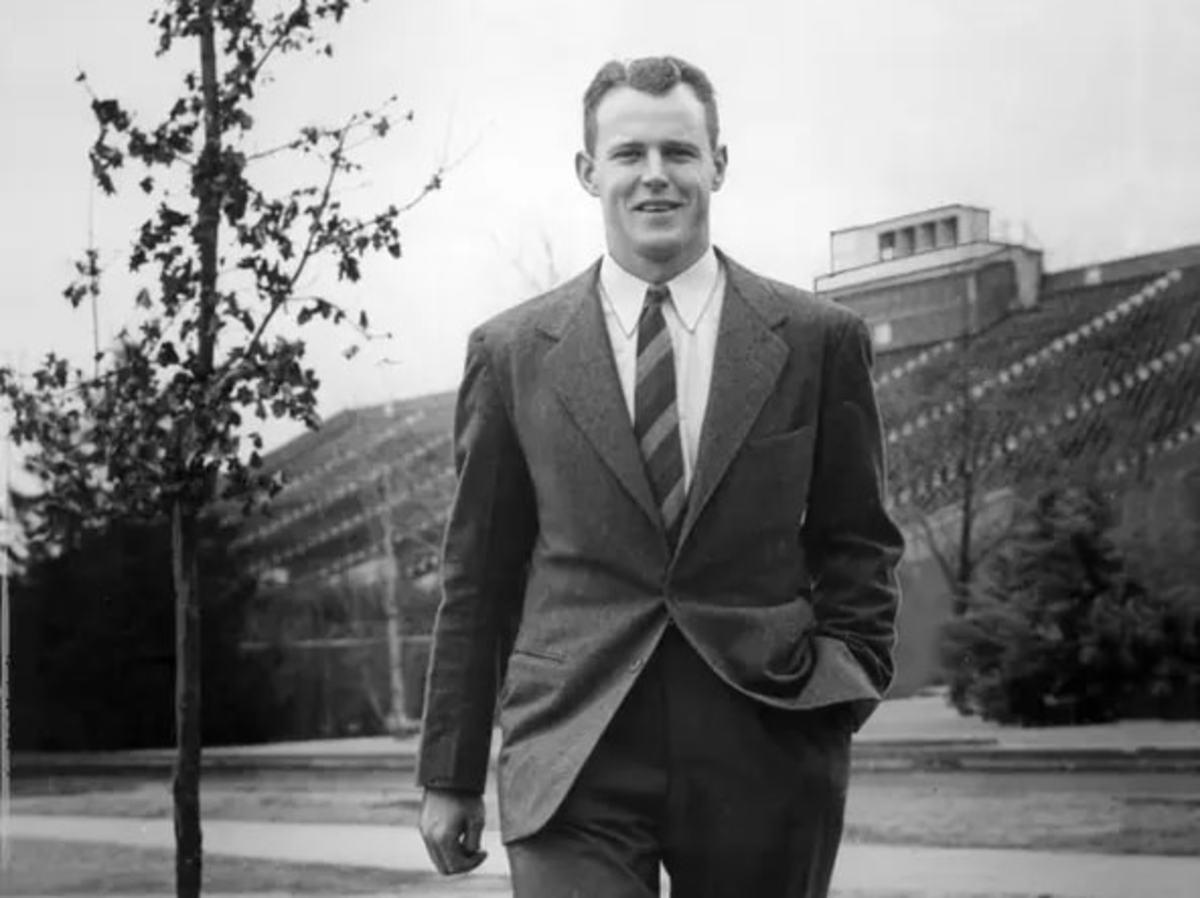
1947: Oklahoma 14, Nebraska 13. Bud Wilkinson’s first Oklahoma team eked out a win, thanks largely to the Huskers’ inability to field the second-half kickoff. Nebraska ended up one point shy of denying the Sooners a share of the Big Six title and two points away from handing Wilkinson his only conference loss in his first dozen seasons. Nebraska took a 6-0 lead in the second quarter when Cletus Fischer picked off Darrell Royal’s pass and returned it 65 yards down the east sideline.
The leadup to the game included an airing of disagreements between Nebraska students and Oklahoma administrators over the conference’s acquiescence to racial discrimination. | Game details
A postgame melee
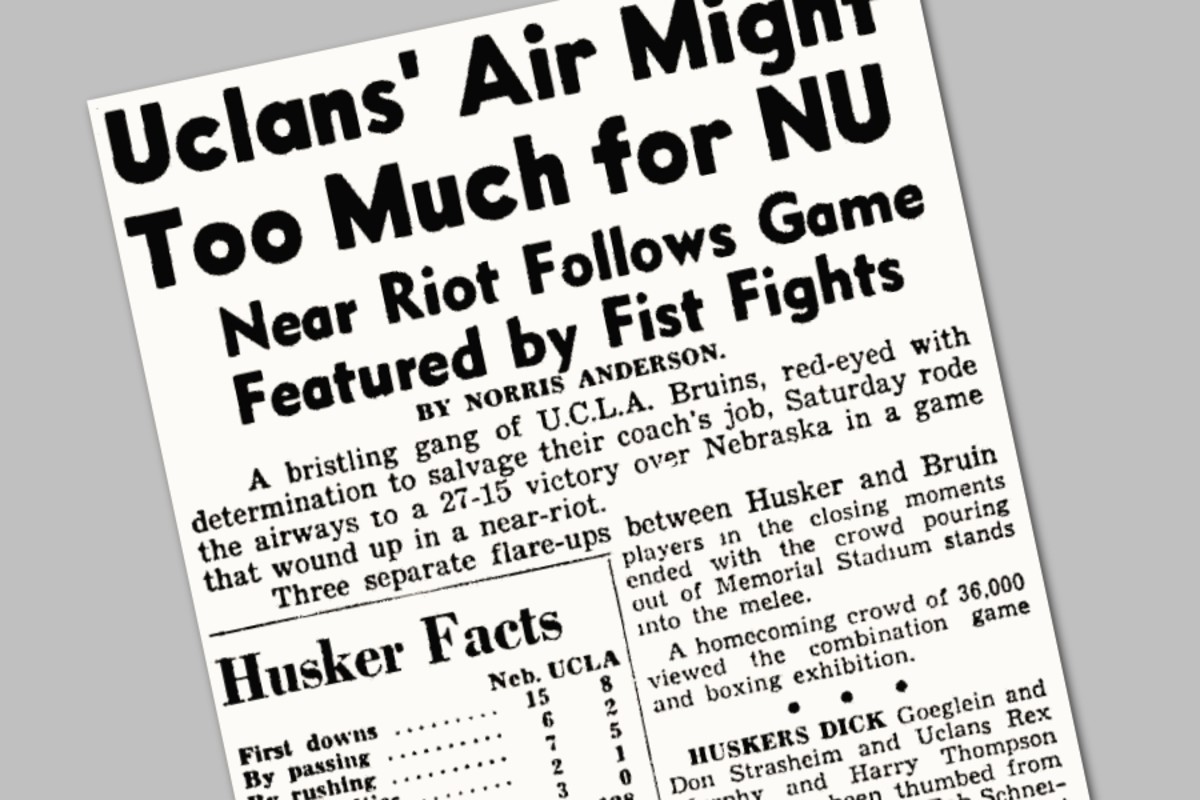
1948: UCLA 27, Nebraska 15. It was described as a near riot: The game ended with Huskers and Bruins throwing punches at each other and police clearing fans from the field. As for the game itself, the Bruins were outyarded but enjoyed a plus-3 turnover margin and exploited Nebraska’s shaky pass defense. Husker stalwarts Tom Novak and Cletus Fischer missed the game with injuries. | Game stories
Last stop for “Train Wreck”
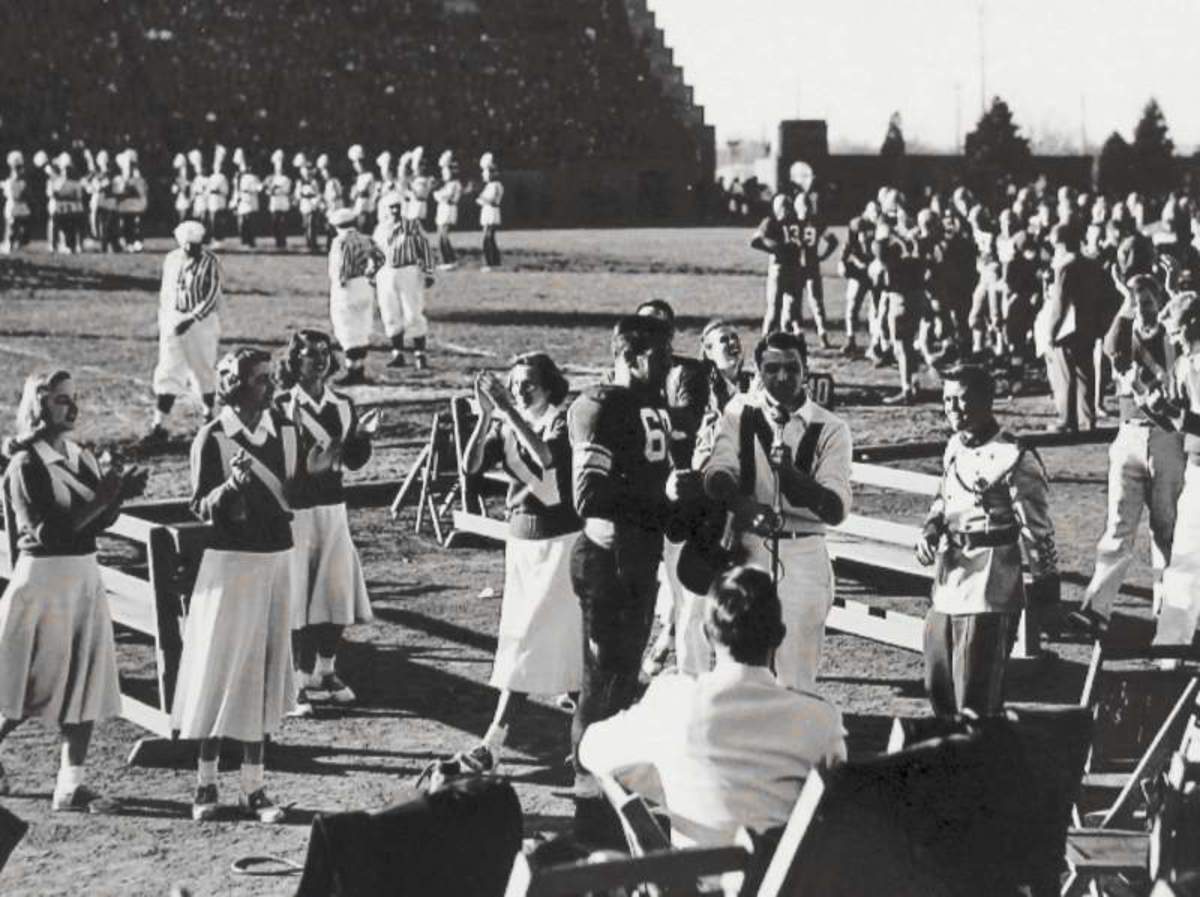
1949: Nebraska 25, Colorado 14. The Huskers capped Bill Glassford’s first season — and Tom Novak’s final one — with a victory that upped their record to 4-5. A 44-yard bomb from Fran Nagle to Frank Simon to the CU 2 shortly before halftime was one of three big plays that crossed up the Buffs, second-year conference members. A halftime ceremony paid tribute to Novak, whose bone-crushing ferocity at linebacker and center earned him the admiration of fans, the respect of opponents and the nickname “Train Wreck.” Novak’s No. 60 was retired after the season, and no Husker has worn it since. | Details
Reynolds’ signature play
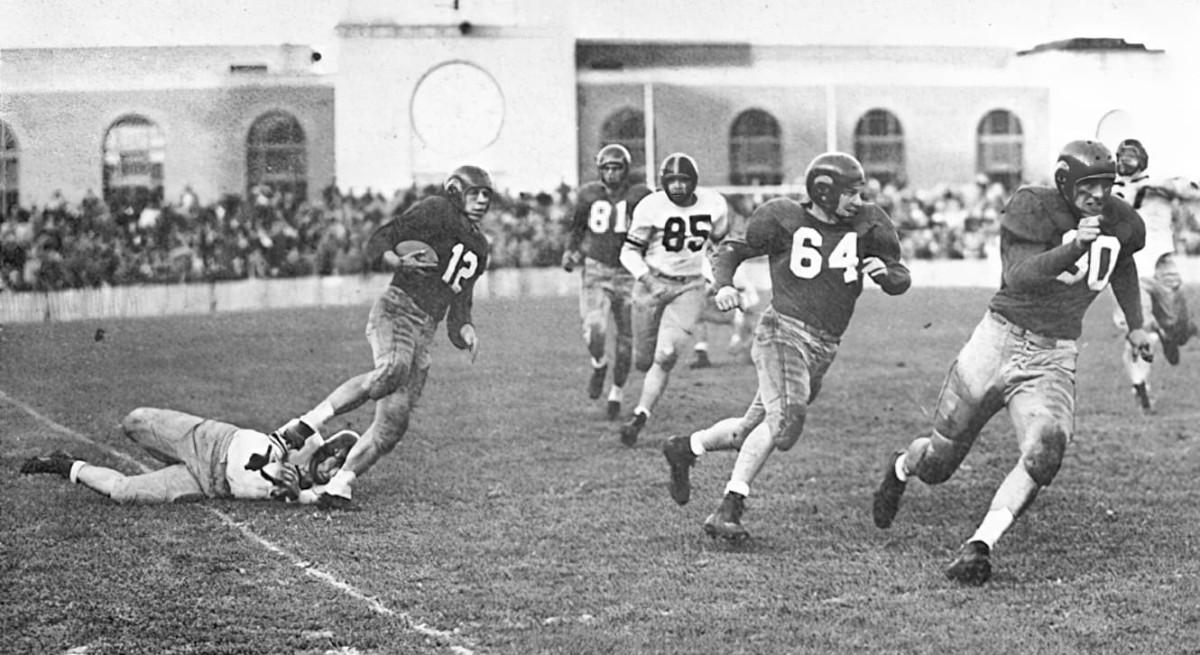
Reynolds steps away from a Tiger during his circuitous scoring jaunt.
1950: Nebraska 40, Missouri 34. It was a shootout like no other in the 60-year history of Nebraska football: Five lead changes in the second half. Each team with at least five touchdowns and 500 yards of offense. And an unforgettable fourth-quarter run by sophomore sensation Bobby Reynolds. The 1950 Huskers would put double digits on the scoreboard in every game and ring up more than 30 points five times. That hadn’t happened since 1915 and 1921, respectively. Reynolds would rush for 1,342 yards in 1950 and set an NCAA single-season scoring record that stood for more than 35 years. There’s video and much more on the HuskerMax game page
A barrier comes down
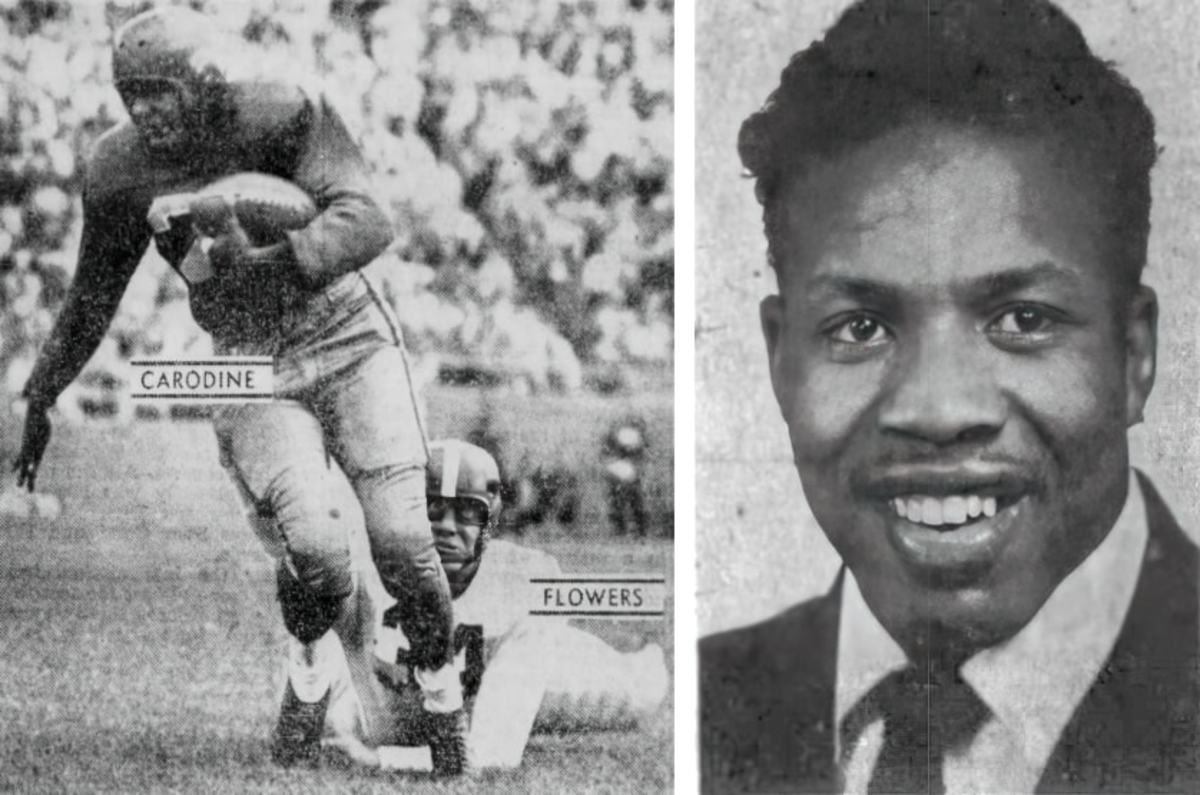
1951: TCU 21, Nebraska 7. After Bobby Reynolds separated his right shoulder at the end of fall camp, others had to pick up the slack in this season opener. Halfback Tom Carodine did just that, rushing for 101 yards in the first varsity action for a Black player for Nebraska since 1913. The game otherwise did not go well for the Huskers, and the same could be said for the rest of Carodine's season. The sophomore from Boys Town was dismissed from the team a few weeks later for skipping classes. (Lineman Charles Bryant would play in 1952, and he and end Jon McWilliams would break the long drought of Black football lettermen in ’53.) | Details
Bad-luck Bobby
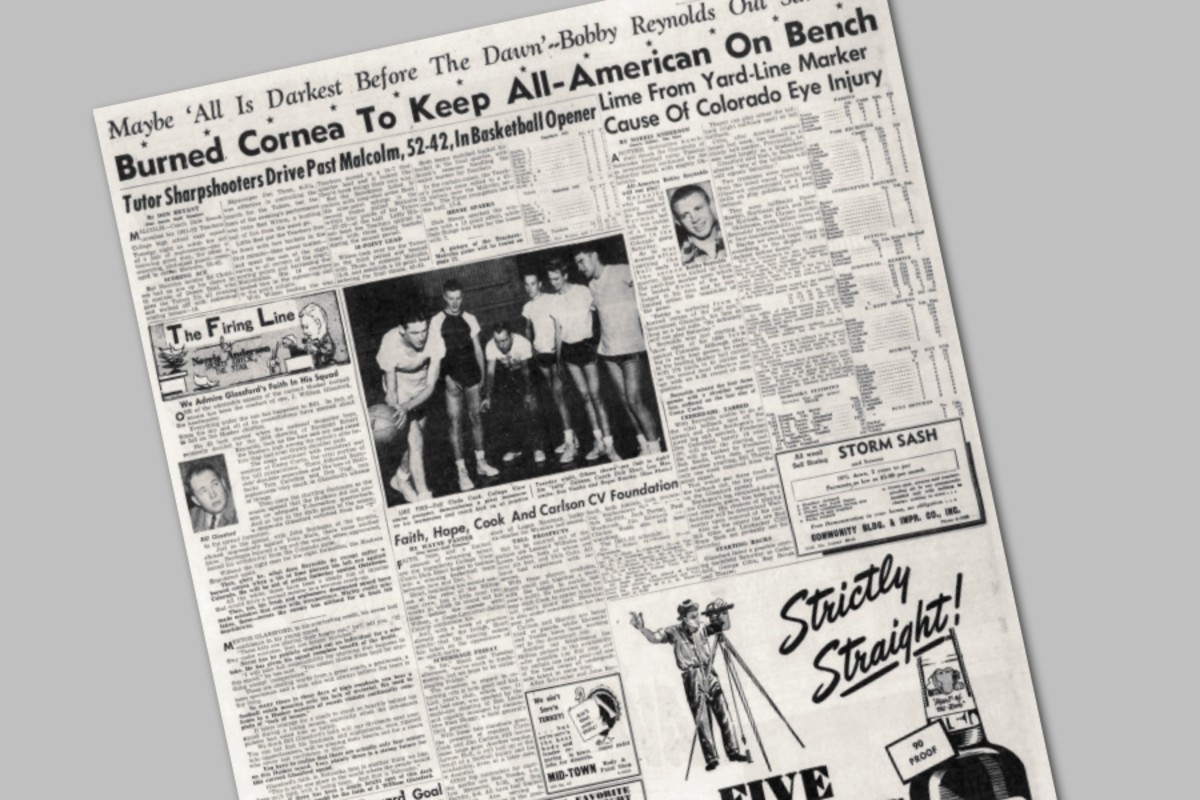
1951: Colorado 36, Nebraska 14. This mid-November game is notable for two reasons: It marked the Huskers’ debut on network TV, and it featured the second whammy of a snakebit junior season for Bobby Reynolds. Just as he was returning to form after his preseason injury, Reynolds suffered a burned cornea against the Buffs when lime from a yard-line marker got lodged in his left eye. He would miss the following week’s shutout loss to Oklahoma as the Huskers finished 0-5 in Memorial Stadium. | Details
Limping to the finish
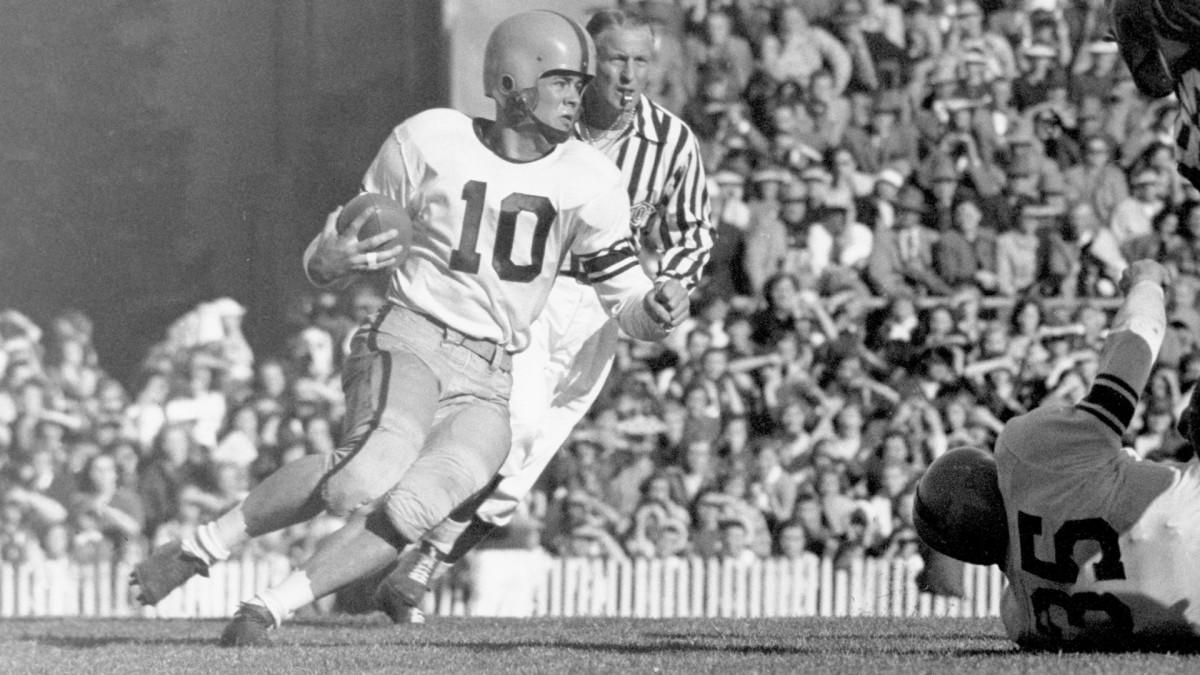
Giel runs for a Minnesota first down in the first half.
1952: Minnesota 13, Nebraska 7. A Hall of Fame tailback was the difference-maker in Nebraska’s home finale, but his name was Paul Giel, not Bobby Reynolds. Five weeks earlier, on Oct. 11, Reynolds had suffered a separation of his left shoulder, and he was held to short gains in this game. Giel, meanwhile, ran and passed for 238 yards in the Gophers' single-wing offense.
The Huskers squandered several scoring chances after Reynolds gave Nebraska a 7-0 lead in the second quarter. That two-yard run turned out to be his final TD in his final game, as a leg injury kept him out of the season finale at Oklahoma. The Huskers finished 5-4-1, but just one win came after Oct. 11. | Details
Postscript: It could’ve been worse
Just one major-college team piled up more losses than Nebraska’s 57 during this stretch, and it was a whole bunch more: 82 times did Kansas State go down to defeat. KSU finished last in the conference all 10 seasons while winning a grand total of two conference games and just nine games overall.
Including KSU’s forfeit of a 6-6 tie game with the Huskers in 1951, Nebraska went 10-0 against Kansas State. That accounted for nearly a third of the Huskers’ wins and more than a quarter of their home victories.
